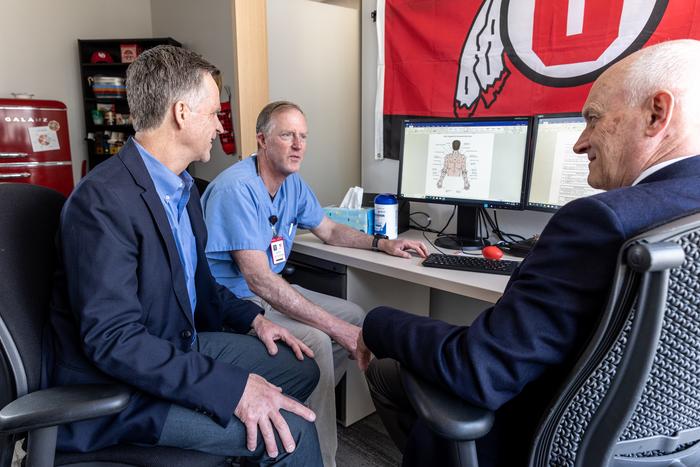People with higher risks of cardiovascular disease are significantly more likely to develop carpal tunnel syndrome, tennis elbow, golfer’s elbow, and rotator cuff tendinitis, according to a new study involving researchers at the University of Utah and the Rocky Mountain Center for Occupational and Environmental Health.

Credit: Charlie Ehlert
People with higher risks of cardiovascular disease are significantly more likely to develop carpal tunnel syndrome, tennis elbow, golfer’s elbow, and rotator cuff tendinitis, according to a new study involving researchers at the University of Utah and the Rocky Mountain Center for Occupational and Environmental Health.
The findings of the study, published June 2 in the Journal of Occupational and Environmental Medicine, have implications for the prevention and treatment of these common musculoskeletal disorders, which affect tens of millions of Americans each year and result in annual costs of more than $6 billion.
The lead author of the study is Kurt Hegmann, M.D., a University of Utah professor and the director of the Rocky Mountain Center for Occupational and Environmental Health, a partnership between the University of Utah and Weber State University. He said the strength of the associations the researchers discovered between cardiovascular disease risk factors and musculoskeletal disorders is staggering.
“It’s rare that you see 17-fold risks of diseases,” Hegmann said. “These results tell us that prioritizing cardiovascular health is a key to preventing these musculoskeletal disorders, which can have a debilitating impact on people’s quality of life. This is something we and other researchers and medical professionals need to be paying a lot of attention to.”
The authors based their research on data from a nine-year prospective cohort of 1,224 workers across various employment sectors in three states. Baseline data were collected at the beginning of the study, including from interviews, physical exams, anthropometric measurements, and nerve conduction studies, with follow-ups conducted monthly to track the development of symptoms of musculoskeletal disorders. The authors compared the development of musculoskeletal disorders to cardiovascular disease risk through a method based on the Framingham Heart Study model, a widely used tool to assess a person’s 10-year risk for cardiovascular disease. They adjusted their analyses for a number of factors that could skew the results, such as body mass index and the physical strain of participants’ jobs.
The findings suggest that poor cardiovascular health contributes to the development of musculoskeletal disorders. Participants at 15% or higher risk of cardiovascular disease were:
- at four times greater risk of developing one or more musculoskeletal disorders than those at low risk of cardiovascular disease
- at 17 times greater risk of developing four or more musculoskeletal disorders than those at low risk of cardiovascular disease
“The importance of heart health is obviously no secret,” said Matthew Thiese, PhD, a co-author from the Rocky Mountain Center for Occupational and Environmental Health. “We know that people need to engage in healthy behaviors so they don’t develop diseases that can shorten their lives. But this study shows that bad outcomes related to musculoskeletal disorders may also be waiting for people who aren’t taking care of their cardiovascular health.”
The musculoskeletal disorders the researchers examined are common among Americans and can impair a person’s quality of life. Previous research estimates that up to 5% of the population suffers from carpal tunnel syndrome, for instance, with much higher prevalence among workers whose jobs require forceful movements, while up to 41% of people experience tennis elbow, or lateral epicondylitis. Up to one-third of people develop rotator cuff tears.
According to the authors, the study prompts questions regarding whether these kinds of conditions are a potential “early warning” signal for cardiovascular disease. Musculoskeletal disorders may occur in a person with poor heart health years or decades before symptoms of cardiovascular disease emerge.
The findings align with a growing body of evidence that systemic risk factors contribute to developing musculoskeletal disorders. Limitations of the research include that the study was not a randomized control trial. Randomized studies are the gold standard in proving causality, though these types of exposures cannot be randomized.
The other co-authors associated with the University of Utah included Eric Wood, MD, and Richard Kendall, MD. They conducted the study in collaboration with researchers from the University of Wisconsin-Milwaukee, Infinity Healthcare in Wisconsin, and the Clement J. Zablocki Veterans Affairs Medical Center in Wisconsin.
About University of Utah Health
University of Utah Health provides leading-edge and compassionate care for a referral area that encompasses Idaho, Wyoming, Montana, and much of Nevada. A hub for health sciences research and education in the region, U of U Health has a $458 million research enterprise and trains the majority of Utah’s physicians, and more than 1,670 scientists and 1,460 health care providers at its Colleges of Health, Nursing, and Pharmacy and Schools of Dentistry and Medicine. With more than 20,000 employees, the system includes 12 community clinics and five hospitals. U of U Health is recognized nationally as a transformative health care system and provider of world-class care.
Journal
Journal of Occupational and Environmental Medicine
DOI
10.1097/JOM.0000000000002895
Method of Research
Observational study
Subject of Research
People
Article Title
Cardiovascular Disease Risk Factors Predict the Development and Numbers of Common Musculoskeletal Disorders in a Prospective Cohort
Article Publication Date
2-Jun-2023




